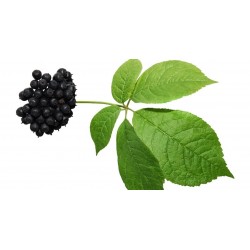- -15%









Eleutherococcus senticosus (synonymAcanthopanax senticosus) is a species of small, woody shrub in the family Araliaceae native to Northeastern Asia. It is often colloquially referred
Eleutherococcus senticosus (synonymAcanthopanax senticosus) is a species of small, woody shrub in the family Araliaceae native to Northeastern Asia. It is often colloquially referred to as Siberian Ginseng, eleuthero or Ciwujia. E. senticosus has a history of use in traditional Chinese medicine where it is known as cì wǔ jiā (刺五加).
Ethnomedical use
E. senticosus is thought to be an adaptogen and there is a wide range of health benefits attributed to its use in herbal medicine.
Chemical constituents
The major constituents of E. senticosus are ciwujianoside A-E, eleutheroside B (syringin), eleutherosides A-M, friedelin, isofraxidin and acanthoside-D
In Chinese herbology, E. senticosis is used by people with bone marrow suppression caused by chemotherapy or radiation, angina, hypercholesterolemia, and neurasthenia with headache, insomnia, and poor appetite.
Synonyms
E. senticosus has been marketed in the United States as Siberian Ginseng because it is believed to have similar herbal properties to those of Panax ginseng. However, it belongs to a different genus in the family Araliaceae, and it is currently illegal in the United States to market eleuthero as Siberian Ginseng, since the term "ginseng" is reserved for species in the Panax genus.
Growth
The herb grows in mixed and coniferous mountain forests, forming low undergrowth or is found in groups in thickets and edges. E. senticosus is sometimes found in oak groves at the foot of cliffs, very rarely in high forest riparian woodland. Its native habitat is East Asia, China, Japan, and Russia. E. senticosus is broadly tolerant of soils, growing in sandy, loamy, and heavy clay soils with acid, neutral, or alkaline chemistry and including soils of low nutritional value. It can tolerate sun or dappled shade and some degree of pollution. E. senticosus is a deciduous shrub growing to 2m at a slow rate. It is hardy to zone 3. It flowers in July in most habitats. The flowers are hermaphroditic and are pollinated by insects.
E. senticosus is a thought to be an adaptogen and there is a wide range of health benefits attributed to its use in herbal medicine.
In Chinese herbology, E. senticosis is used by people with bone marrow suppression caused by chemotherapy or radiation, angina, hypercholesterolemia, and neurasthenia with headache, insomnia, and poor appetite.
Comments:
Shrub from Northeast China, the root has been used for centuries in China and Russia to restore vigor, increase longevity, help with memory, and help the body to deal with stress.
Characteristics
Medicinal
Moist Soil
Shade Tolerant
Flowering Shrub
Urban Tolerant
Ornamental Fruit
Growing Info:
Scarification: Soak in water, let stand in water for 24 hours
Stratification: warm stratify for 6 months, cold stratify for 30 days
Germination: seed may start to germinate in cold strat., sow seed 1/4" deep, tamp the soil, mulch the seed bed

 Reviews (0)
Reviews (0)